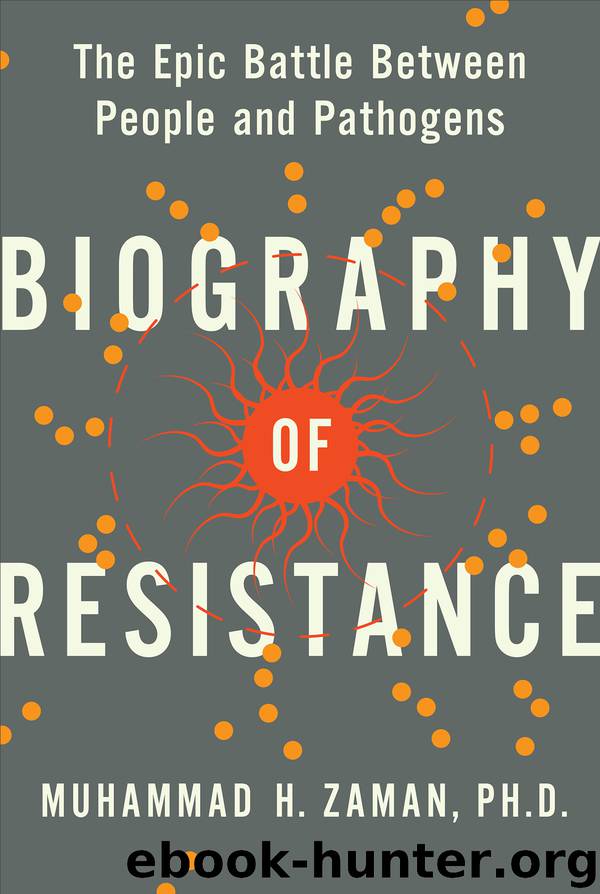Biography of Resistance by Muhammad H. Zaman

Author:Muhammad H. Zaman
Language: eng
Format: epub, azw3
Publisher: HarperCollins
Published: 2020-04-21T00:00:00+00:00
Midtvedt’s home country of Norway has become synonymous with quality salmon all around the world;3 much of the available salmon comes from Norwegian fish farms. The grocery store near my home in the suburbs of Boston sells it year round. Midtvedt, it turns out, had a role to play in the growth of the salmon industry. The fish in grocery stores all across America and in other parts of the world is there thanks to a vaccine that was developed to protect the fish from yet another threat of rising resistance due to industrial-use antibiotics.
The massive growth that we’ve seen in Norway’s salmon industry over the years took off in the 1980s with the advent of modern fish farms. A typical farm consists of several large circular cages placed side by side in the sea. Some cages are only ten meters in diameter, but others can be as large as half a soccer field. They can be as deep as they are wide. These cages contain nets that can hold up to one hundred thousand salmon. Some even larger cages can hold nearly a quarter of a million salmon.
As the farming sector expanded, exports increased, but so did the spread of a devastating fish disease called furunculosis. To protect their livelihoods and their salmon, the farmers in Norway started using antibiotics as prophylaxis by adding it directly to the feed for the fish.
As the scale of the fish farming industry grew, so did the use of antibiotics. By the late 1980s, demand was such that the farmers were using cement mixers to mix antibiotics into the fish food. Midtvedt grew concerned. His years of research and his ever more detailed database told him that this method of farming could greatly affect the waterways, the environment, and the public in general.
By the mid-1980s he started writing about it publicly. And after obtaining data from the relevant government departments, he found that humans in Norway were prescribed twenty-four tons of antibiotics per year. Salmon consumed forty-eight tons. The fact that twice as many tons of antibiotics were being given to the Norwegian salmon than to all the people in Norway was alarming. That the “antibiotic-enhanced” fish food was being dumped directly into fish farms, and from there could get into the surrounding water, was even more so. Midtvedt pushed for some response from the Norwegian government, hoping it would enact regulations to protect environmental and public health, but fish farming was a lucrative and highly profitable business and a major source of tax revenue. He was met with fierce resistance by the fish farming lobby, and by veterinarians who had strong ties to the fish farmers.
Download
This site does not store any files on its server. We only index and link to content provided by other sites. Please contact the content providers to delete copyright contents if any and email us, we'll remove relevant links or contents immediately.
| Cell Biology | Developmental Biology |
| Entomology | Marine Biology |
| Microbiology | Molecular Biology |
| Biostatistics |
Sapiens: A Brief History of Humankind by Yuval Noah Harari(14252)
The Tidewater Tales by John Barth(12608)
Mastermind: How to Think Like Sherlock Holmes by Maria Konnikova(7227)
Do No Harm Stories of Life, Death and Brain Surgery by Henry Marsh(6891)
The Thirst by Nesbo Jo(6827)
Why We Sleep: Unlocking the Power of Sleep and Dreams by Matthew Walker(6618)
Life 3.0: Being Human in the Age of Artificial Intelligence by Tegmark Max(5474)
Sapiens by Yuval Noah Harari(5294)
The Longevity Diet by Valter Longo(5019)
The Body: A Guide for Occupants by Bill Bryson(4974)
The Rules Do Not Apply by Ariel Levy(4861)
The Immortal Life of Henrietta Lacks by Rebecca Skloot(4525)
Animal Frequency by Melissa Alvarez(4395)
Why We Sleep by Matthew Walker(4360)
The Hacking of the American Mind by Robert H. Lustig(4318)
Yoga Anatomy by Kaminoff Leslie(4306)
All Creatures Great and Small by James Herriot(4232)
Double Down (Diary of a Wimpy Kid Book 11) by Jeff Kinney(4207)
Barron's AP Biology by Goldberg M.S. Deborah T(4097)
